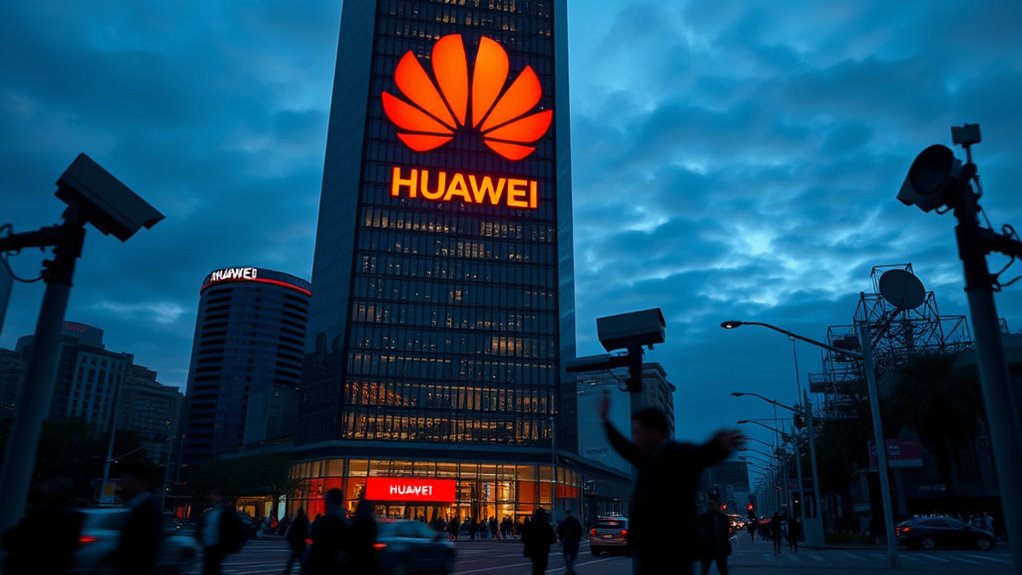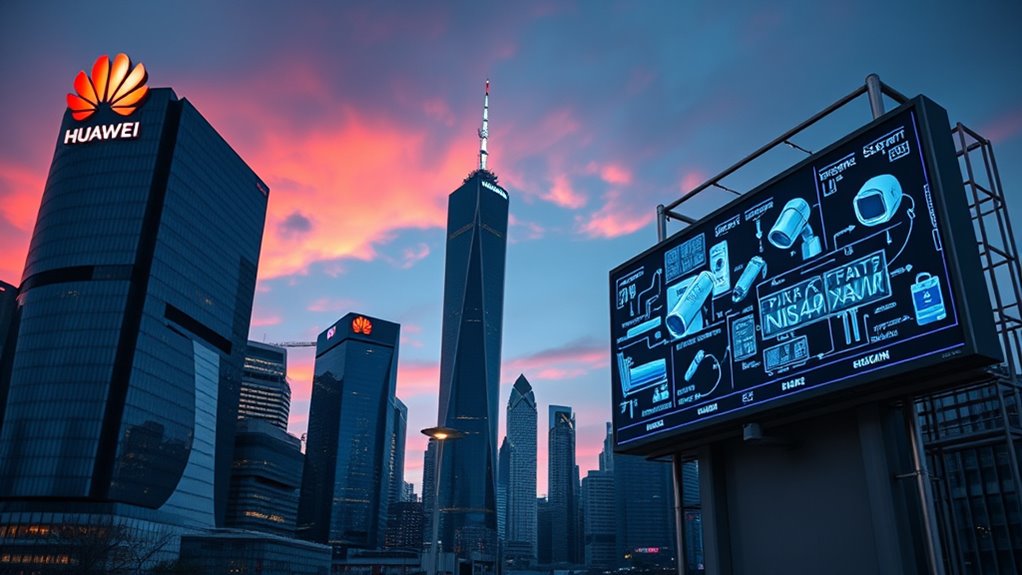Huawei’s rise from a small electronics maker to a global telecom leader showcased its innovation and rapid expansion, especially in 5G technology. However, international sanctions and security concerns started to cast doubt on its operations, limiting access to essential US-made components. Governments worry about security threats, leading to bans and slowed deployments. Despite efforts to innovate around restrictions, challenges persist. If you explore further, you’ll discover how geopolitical tensions continue shaping Huawei’s future and global tech landscape.
Key Takeaways
- Huawei evolved from a small electronics firm to a global leader in 5G technology and telecommunications infrastructure.
- International sanctions restricted access to US-made components, hindering Huawei’s product development and global expansion.
- Security concerns led many countries to ban or limit Huawei’s 5G deployments, affecting its international market presence.
- Huawei responded by investing in R&D and developing proprietary chips to reduce dependency on foreign technology.
- Geopolitical tensions and security fears have transformed Huawei from a tech innovator into a perceived security threat on the global stage.

Huawei has ascended from a small electronics manufacturer to a global telecommunications giant, driven by innovative technologies and aggressive expansion. You’ve watched the company push boundaries in 5G implementation, making it a leader in next-generation wireless networks. Its rapid deployment of 5G infrastructure has positioned Huawei at the forefront of global connectivity, with many countries relying on its equipment to upgrade their networks. But this aggressive expansion hasn’t come without hurdles. International sanctions, especially from Western nations, have significantly impacted Huawei’s growth trajectory. These sanctions restrict the company’s access to vital US-made technologies, including advanced semiconductor components, which are critical for developing cutting-edge 5G hardware. As a result, Huawei faces delays in rolling out certain products and struggles to source the components needed to maintain its technological edge.
You might notice how these restrictions have created a complex web of challenges. While Huawei has tried to develop its own chipsets and supply chains, it’s not always able to match the quality or scale of Western suppliers. The sanctions also cast a shadow over the company’s international ambitions, forcing it to reconsider its strategy in many markets. Countries that once eagerly adopted Huawei’s 5G solutions now grapple with security concerns raised by their allies, leading to bans or slowed deployments. This geopolitical pressure underscores how international sanctions aren’t just economic tools—they influence the very fabric of Huawei’s global presence.
Despite these setbacks, Huawei remains resilient. The company’s emphasis on research and development has allowed it to innovate around restrictions, pushing forward with alternative solutions. You can see this in their efforts to develop proprietary chips and software, reducing dependency on foreign technology. However, the reality is that the sanctions limit Huawei’s ability to fully capitalize on its technological advancements, and competitors gain ground in the 5G race. The company’s future hinges on how successfully it can navigate these international restrictions while maintaining its reputation as a telecom innovator.
In essence, Huawei’s story is a testament to how geopolitical dynamics directly influence technological progress. Its rise in 5G implementation showcases its technical prowess, but international sanctions reveal the vulnerabilities a company faces when caught in the crossfire of global politics. For you, observing Huawei’s journey offers a glimpse into how national security concerns and diplomatic strategies shape the future of global technology development. It’s a reminder that innovation doesn’t happen in a vacuum—and that global security considerations will continue to influence the tech landscape for years to come.
Frequently Asked Questions
What Specific Security Concerns Do Governments Have About Huawei?
You’re concerned about Huawei because governments worry about cyber espionage, where sensitive data could be stolen or compromised. They also fear supply chain security issues, suspecting that Huawei’s equipment might include hidden backdoors or malicious hardware that could be exploited. These risks threaten national security and infrastructure, making authorities hesitant to trust Huawei’s technology without strict oversight or restrictions, especially in critical communications networks.
How Has Huawei’s Global Market Share Changed Over the Last Decade?
Imagine a soaring bird tracing a bold, upward curve—your view of Huawei’s market share over the last decade. Its growth trajectory has been remarkable, capturing a significant portion of the global telecom landscape. You see it rising steadily, expanding into new markets, but recent geopolitical storms have caused some turbulence. Despite challenges, Huawei’s influence remains substantial, shaping the future of tech and connectivity worldwide.
What Alternative Technologies Are Replacing Huawei’s Products?
You might notice emerging competitors like Samsung and Apple offering alternative networks and devices that replace Huawei’s products. These companies develop advanced smartphones, 5G infrastructure, and telecom equipment, providing reliable options for consumers and businesses. As Huawei faces restrictions, these alternative networks become more prominent, encouraging you to explore new brands and technologies that meet your needs without depending on Huawei’s offerings.
How Does Huawei’s Corporate Governance Impact Its International Reputation?
Think of Huawei’s reputation as a fragile glass sculpture—you hold it carefully, but corporate governance can either strengthen or shatter it. When you prioritize corporate transparency and leadership accountability, you build trust internationally. Conversely, lack of openness can raise suspicions and damage relationships. Your actions in governance directly influence how the world perceives Huawei, making it essential to maintain integrity and clarity to sustain a positive global reputation.
What Are Huawei’s Future Plans Amid Ongoing Restrictions?
You should watch how Huawei plans to expand in emerging markets, focusing on strengthening local partnerships and diversifying supply chains. Their innovation strategies likely include investing in 5G, AI, and alternative technologies to bypass restrictions. By prioritizing these approaches, Huawei aims to maintain growth and competitiveness despite ongoing challenges. Staying adaptable and fostering innovation will be key to their future success amid international restrictions.
Conclusion
As you watch Huawei’s journey unfold, it’s clear how quickly success can turn to scrutiny, almost as if fate had a hand in shaping its story. From a tech champion to a security concern, the company’s rise and struggles seem intertwined by more than just market forces. In the end, what’s a coincidence today could be tomorrow’s turning point, reminding you that even the most remarkable breakthroughs carry shadows, waiting quietly just beyond the spotlight.









